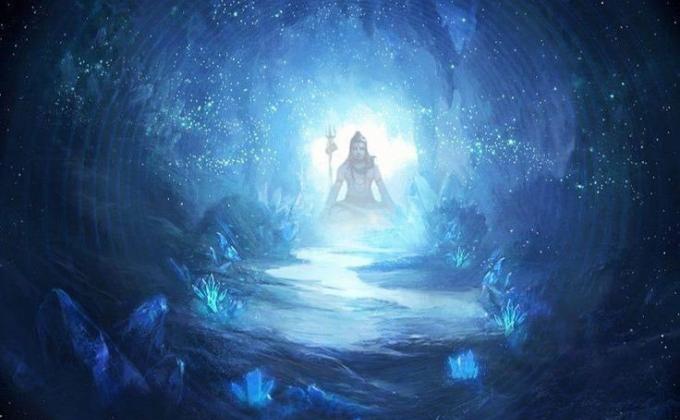
Ashrami Aleksandr ॐ
10 mai 2023 - 09:40Bhakti yoga
A spiritual mental state is divine bhava. Bhava is very important in meditation and worship.
A spiritual mental state is divine bhava. Bhava is very important in meditation and worship.
The realization that everything is Brahman, “I Am Brahman,” that the individual soul and the Supreme Spirit are one, and that nothing exists except Brahman, is brahma-bhava, or the highest stage. Sri Dattatreya, Sri Sankara, Sri Yajnavalkya possessed this supreme bhava. For such realized sages, there is no worshiper, no object of worship, no yoga, no puja, no dharana, dhyana, japa, stava or gate.
Continuous meditation through the yoga process on Devat in the heart is dhyana-bhava. Japa, hymns and prayer are a little lower. Puja-bhava is the lowest of all bhavas. Puja bhava arises from the dualistic notions of the worshiper and the object of worship, servant and Lord.
You cannot immediately possess all brahma-bhava. You should slowly climb the stairs of bhava: from puja-bhava - to dhyana-bhava, and from dhyana-bhava - to brahma-bhava. The heart must be thoroughly cleansed through japa, hymns, prayer and meditation.
Bhava is an inner feeling. There are three types of bhavas: sattvic bhava, rajasic bhava and tamasic bhava - according to the nature of the qualities that prevail in a person.
Sattvic bhava is divine bhava. That is suddha-bhava. Just as a thought, or memory, or a will can develop or “improve in an exercise, so can bhava.
Bad bhava can be converted into good bhava. Bhavas of friendliness or enmity are all mental constructions. Enemy or friend - they are not somewhere outside the mind. It is a feeling or imagination that is within. The oldest and most bosom friend can become a mortal enemy in an instant. One harsh or rude word in the blink of an eye completely changes the situation.
The Vedanta says: "A person is indistinguishable from Brahman (Existence-Absolute) when he gets rid of his ignorance." Man mistakenly identifies himself with his body and in this false dream he imagines that he is a small jiva with small powers and small knowledge. That is his bhava at the present moment. This is human bhava. It should be changed to brahma-bhava, changing the angle of view and way of thinking. Think You Are Brahman. Think of yourself that you are a pure, omnipresent mind, light and consciousness.
Think that you are immortal. Think that you are omnipotent, omniscient, and omnipresent. Think you are Sakshi. Fill yourself with sakshi-bhava and akarta-bhava: "I am observing from the side, I am not doing, not experiencing pleasure." By this practice, you can destroy the idea of activity and the enjoyer, free yourself from the shackles of karma and achieve the state of Brahman, or the highest bliss, knowledge and immortality. The Vedanta also adds: “See and feel Brahman in everything and neglect names and forms.” She also teaches you to develop atma-bhava or brahma-bhava through vicara and proper thinking and meditation.
When a concept completely masters the mind, a mental state or bhava, corresponding to the nature of the concept, enters. Think about your foe for a while, and a hostile bhava will manifest. Meditate on mercy or universal love - prema-bhava or karuna-bhava will manifest. Sensation always accompanies thinking. You cannot separate thinking from sensation. They are like fire and heat.
You should keep the state of mind in your field of vision with the help of careful and vigilant self-observation and not allow the negative and undesirable bhavas to manifest. You should immediately replace bad bhava by thinking about the opposite bhava. The positive will prevail over the negative.
Sattvic bhava is your valuable spiritual capital. You must constantly try to establish yourself in brahma-bhava through the sattvic bhava.
The beginning of this struggle will not be easy for us. There will be an internal war between asurika and divine bhavas. The former inhabitants of your mind will have the strength to rush back into the inner factory of the mind. But over time and through constant practice, the sattwic bhava will gain the upper hand. What we eat, what food we eat, has a very direct effect on bhava.
Sattvic food very easily produces sattwic bhava. Plant yourself at least for a day solely on milk and fruit and observe your mind and bhava. You will have a wonderful calm mind with sattvic bhava. When there is this sattvic bhava, the mind naturally rushes to God and meditation comes by itself, without the least effort on your part.
The believer’s thoughts are invariably that the arbiter of everything is God and he is only an instrument in the hands of God. He thinks of himself only as nimitta, and that is his bhava. Feeding this bhava, he rejects the idea of activity and enjoyment, and thereby frees himself from the shackles of karma.
He is in perfect, indestructible peace, developing this bhava. If something happened, desired or unwanted, he will say: “God is in everything. God does everything for my good. God is fair. Thy will be done. All is yours. I am Yours, my Lord. ” By practicing this bhava, he is always happy, under any circumstances, in any living conditions.
The bhavas of bhakta and vedantina are different. Vedantin is in saksha and akarta-bhava.
Bhakta is in nimitta-bhava.
Vedantin develops brahma-bhava.
Bhakta develops dasya bhava.
Vedantin identifies himself with Brahman.
Bhakta nourishes the bhava of duality. He worships and adores. But ultimately, through para-bhakti, bhakta also attains jnana and attains the state that the jnana attains. The types of sadhana and bhava differ only in the beginning. As a result, they meet on the same basis.
The rich man and the pandit - they have bhava of arrogance and arrogance.
A genuine sannyasi has bhava of equality, identity and love.
Bhava is different in different people - in accordance with nature and inclinations. Speaking in a secular language, the relations of father and son, husband and wife, master and servant, friend and friend, brother and sister, etc. are designed to develop various degrees of prema and continue this prema to God, purifying the lower feeling into a higher subtle divine feeling. These are the goal and object — the lower human bhava is transformed into the higher divine bhava. Worldly connections and bhava are preparatory exercises for the development of divine bhava.
